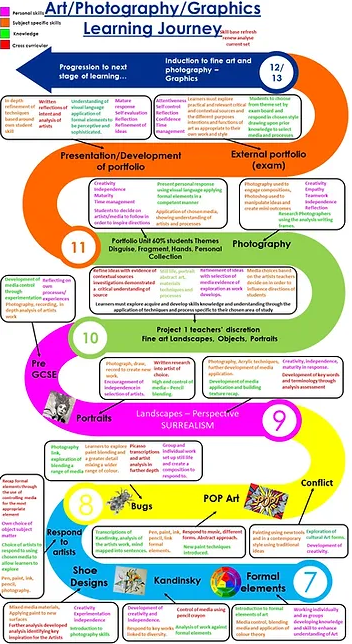Curriculum Intent
Opening the eyes, hearts and minds of students. We want to develop understanding and appreciation of the world in which we live.
Studying Art, Craft and Design helps to create a broad and balanced curriculum, which is an excellent foundation for life. Learning through and about Art enriches the cultural experiences of children. Our Art curriculum encourages self-expression, creativity as well as a sense of individual identity.
At the heart of our department vision, Art will aim to develop creative thinking, with equality for communication, inclusivity and visual expression, where every child can feel safe to succeed.
Learning through and about the arts enriches the experience of studying while at school as well as preparing students for life after school. G.C.S.E Art, Craft and Design encourages self-expression, creativity and can build confidence as well as a sense of individual identity.
Studying arts subjects also help to develop critical thinking and the ability to interpret the world around us.
The National Gallery Read More >
The Wallace Collection Read More >
V&A Read More>
The Photographers' Gallery Read More >
The Line Read More>
National Portrait Gallery Read More>
Tate Read More >
Saatchi Gallery Read More>
The Design Museum Read More >
London Graffiti Tours Read More >
Year 7
Students learn the basic skills using the formal elements of Art and design: Line, Shape, Tone, Colour, Pattern, Form, and Texture. Students learn how to use the pencil to create tone and draw from observation, making objects look real. Colour theory and how colour is used to create emotion, feeling and meaning. Students learn how to analyse art work and make connections with traditional and contemporary artist to inspire their own work.
Year 8
Students expand on the basic skills project and create a sustained creative journey on skill and techniques. Students use Pop Art to make creative links to inspire own outcomes. Observing bugs as a stimulus students create sections of mark making skills and techniques using a variety of different media. Learning how to apply certain marks with control when creating a missed media approach.
Year 9
Students cover more breadth of the Arts and study 6 themes across the year. Students expand on their skills and techniques and get them refining work more in order to challenge their mind set of what art is and can be. Students build on skills and techniques that are required at GCSE. Students are given more input in what projects, resources, artist links they make to give students independence, ownership of their work. Students learn how to present work, record ideas and develop work into final outcomes to prepare them for Art GCSE and A Level.
Year 10
Students learn how to create a successful project to GCSE standard. How to develop ideas, refine ideas, adapt, modify what is working to improve, record ideas and develop ideas into final outcomes. Students cover more themes and revisit themes such as Portraits to further push their ideas. Students are encouraged to work on their strengths and new skills in Photography, Photoshop, and Digital media are encouraged to motivate, enthuse, and inspire students’ ideas
Year 11
Students embark on their 60% unit where they pick one starting point out of: Disguise, Fragment, Personal Collection and Hands. Students develop initial ideas, make connections with artists, and start experimenting with different media to develop ideas, record detailed observational drawings, use their own photography, digital media, and tablet work to execute a sustained personal presentation. Students are prepared for the externally Set Task, set by the exam board with 5 starting points. Students select one to prepare work up to the exam where the students create a final outcome over 2 days that takes 10hrs to complete.
Year 12
Students are inducted into 3 areas of study; Art, Photography and Graphic Design. Students in art produce a journal and have a topic a week to engage with and create a journal that takes them up Christmas. Photography. Students produce a set of work around the senses and in Graphic Design students are encouraged to develop ideas around experiments with Typography. The spring students are sent the exam paper for their AS with 7 themes on it. Students pick one to develop work which compiles of preparatory work and a 10hr exam at the end. Students prepare for year 13 before the end of year 12.
Year 13
Students pick their starting point having researched likely starting point themes. Students then sustain a personal creative journey that encompasses development of ideas, refined experiments in a variety of media, recording through detailed drawing, painting, and digital media to create a final outcome at the end. This is worth 60% of their A Level. In the spring students’ are sent by the exam board 7 starting points to develop work and preparatory work on a sustained creative journey with a 15hr hour exam at the end worth 40% of the A Level. This also includes a written element called the related study where students write an analytical assignment that accompanies the practical work.
Exam Boards and Specifications
GCSE - OCR Level 1/Level 2 GCSE (9-1) in Art and Design (J171)
A Level - OCR Level 3 Advanced GCE in Art and Design (Art, Craft and Design / Fine Art / Graphic Communication / Photography / Textile Design / Three-Dimensional Design / Critical and Contextual Studies) (H601)


